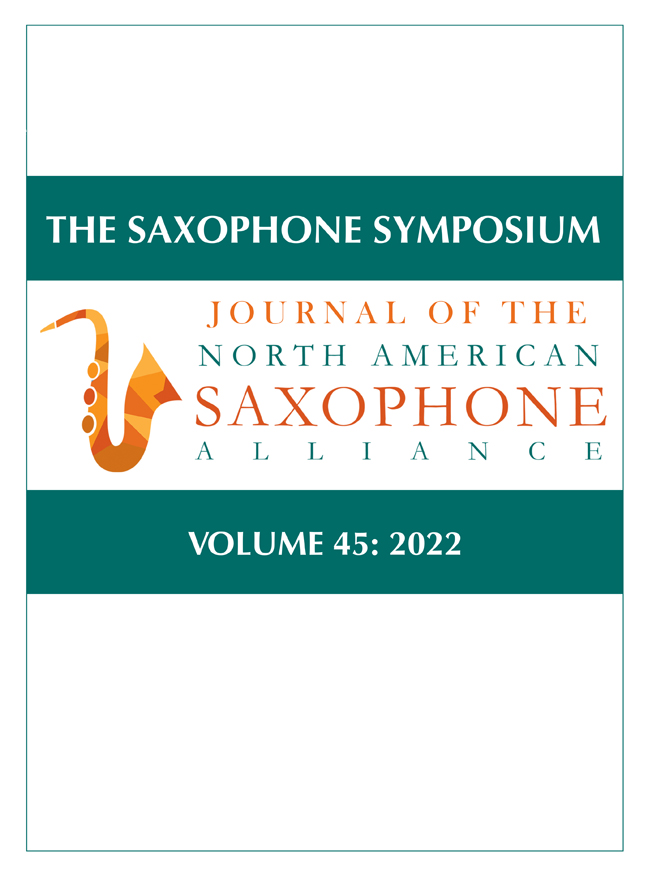Book contents
- Frontmatter
- Contents
- The Saxophone Symposium
- Nasa Executive Committee
- Notice to Contributors
- Financial Reports
- Book part
- List of Featured Concerto Performers at North American Saxophone Alliance Biennial Conferences, 1994–2020
- Asenath Mann: Boston's Gilded-Age Saxophonist
- Zechariah Goh and the Development of Classical Saxophone in Singapore
- Mrs. B. L. Hackenberger: Bessie Mecklem as Progressive-Era Clubwoman
- Elise Hall in Santa Barbara (1889–1898): The Amateur Musical Club and Philharmonic Society
- “Another American Voice” William Grant Still and the Saxophone
- The Manuscript to Jacques Ibert's Concertino da Camera: What We Can Learn from It
- Steven Bryant: In this Broad Earth
- Marco Albonetti, Amarcord d’un Tango
- Contributor Biographies
Marco Albonetti, Amarcord d’un Tango
Published online by Cambridge University Press: 15 February 2024
- Frontmatter
- Contents
- The Saxophone Symposium
- Nasa Executive Committee
- Notice to Contributors
- Financial Reports
- Book part
- List of Featured Concerto Performers at North American Saxophone Alliance Biennial Conferences, 1994–2020
- Asenath Mann: Boston's Gilded-Age Saxophonist
- Zechariah Goh and the Development of Classical Saxophone in Singapore
- Mrs. B. L. Hackenberger: Bessie Mecklem as Progressive-Era Clubwoman
- Elise Hall in Santa Barbara (1889–1898): The Amateur Musical Club and Philharmonic Society
- “Another American Voice” William Grant Still and the Saxophone
- The Manuscript to Jacques Ibert's Concertino da Camera: What We Can Learn from It
- Steven Bryant: In this Broad Earth
- Marco Albonetti, Amarcord d’un Tango
- Contributor Biographies
Summary
Marco Albonetti is a longtime dear friend—a “brother from another mother,” as they say— as well as a collaborator. When he released his second Chandos record, he asked me how it made me feel. Such a simple question. But not a simple answer.
Whereas his first Chandos record was a culmination of over two and a half decades of his fascination with Astor Piazzolla, Amarcord d’un Tango is a deeper inquiry into tango. The first album is filled with energy, ambition, passion, and youth. The second is a bit darker, more emotionally mature, and was curated and created by a more seasoned and— dare I say it—older (and wiser) musician.
It is an exploration of opposites: liturgical and secular, sacred and profane, human and divine, past and present, connection and separation, fantasy and reality, remembering and forgetting, nostalgia and acceptance of the present moment, permanence and impermanence, young and old, love and loss … and, ultimately, life and death.
I believe that the thing that gives human life any meaning at all is the inevitable prospect of death.
And I believe the whole reason for living is to give and receive love.
Somehow, Albonetti and his collaborator Daniele di Bonaventura captured all of this in sound, using the very different but also similar instruments of the soprano saxophone and the bandoneon. The sounds of the instruments themselves are both produced by air moving through reeds, but one originates from inside the body while one emanates from the outside—yet another merging of opposites. I also love that the record moves between duos and larger orchestrations, representing both intimacy and distance.
A specific technical note for careful listeners: Albonetti chooses to use expressive intonation, following in the footsteps of great vocalists and string players. When he sounds a bit flat, one must consult the original text of the tango. He is intentionally text painting with his intonation, using melodic intonation rather than harmonic intonation to express emotions such as sadness or darkness. Playing with pitches between the cracks of an inherently out-of-tune bandoneon is a brilliant artistic technique in this situation. Albonetti means to say what he is saying and in the language in which he is saying it.
One of the more interesting aspects of navigating midlife is that we know we are at least somewhat resilient, because after all, we have made it this far.
- Type
- Chapter
- Information
- The Saxophone SymposiumJournal of the North American Saxophone Alliance, pp. 163 - 164Publisher: Boydell & BrewerFirst published in: 2024



